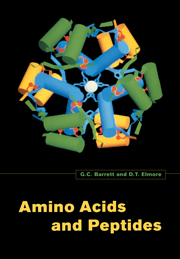Book contents
- Frontmatter
- Contents
- Foreword
- 1 Introduction
- 2 Conformations of amino acids and peptides
- 3 Physicohemical properties of amino acids and peptides
- 4 Reactions and analytical methods for amino acids and peptides
- 5 Determination of the primary structure of peptides and proteins
- 6 Synthesis of amino acids
- 7 Methods for the synthesis of peptides
- 8 Biological roles of amino acids and peptides
- 9 Some aspects of amino-acid and peptide drug design
- Subject index
1 - Introduction
Published online by Cambridge University Press: 05 June 2012
- Frontmatter
- Contents
- Foreword
- 1 Introduction
- 2 Conformations of amino acids and peptides
- 3 Physicohemical properties of amino acids and peptides
- 4 Reactions and analytical methods for amino acids and peptides
- 5 Determination of the primary structure of peptides and proteins
- 6 Synthesis of amino acids
- 7 Methods for the synthesis of peptides
- 8 Biological roles of amino acids and peptides
- 9 Some aspects of amino-acid and peptide drug design
- Subject index
Summary
Sources and roles of amino acids and peptides
More than 700 amino acids have been discovered in Nature and most of them are a-amino acids. Bacteria, fungi and algae and other plants provide nearly all these, which exist either in the free form or bound up into larger molecules (as constituents of peptides and proteins and other types of amide, and of alkylated and ester-ified structures).
The twenty amino acids (actually, nineteen α-amino acids and one α-imino acid) that are utilised in living cells for protein synthesis under the control of genes are in a special category since they are fundamental to all life forms as building blocks for peptides and proteins. However, the reasons why all the other natural amino acids are located where they are, are rarely known, although this is an area of much speculation. For example, some unusual amino acids are present in many seeds and are not needed by the mature plant. They deter predators through their toxic or otherwise unpleasant characteristics and in this way are thought to provide a defence strategy to improve the chances of survival for the seed and therefore help to ensure the survival of the plant species.
Peptides and proteins play a wide variety of roles in living organisms and display a range of properties (from the potent hormonal activity of some small peptides to the structural support and protection for the organism shown by insoluble proteins). Some of these roles are illustrated in this book.
- Type
- Chapter
- Information
- Amino Acids and Peptides , pp. 1 - 19Publisher: Cambridge University PressPrint publication year: 1998
- 1
- Cited by



